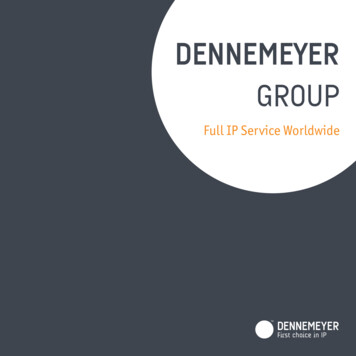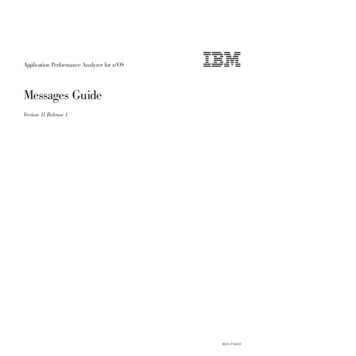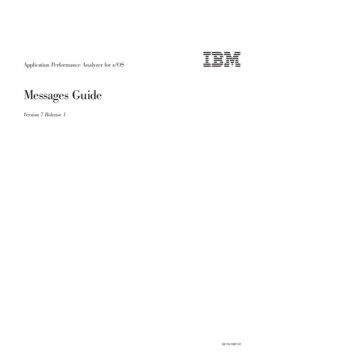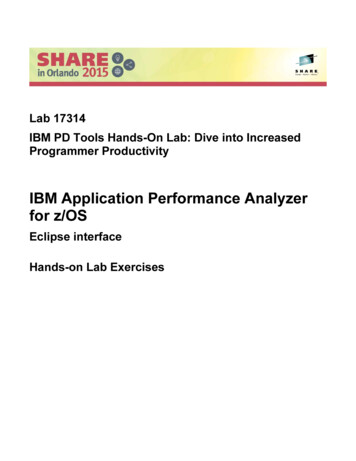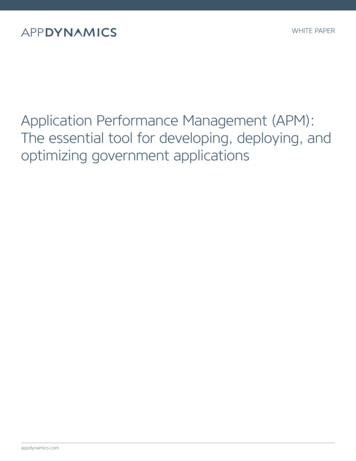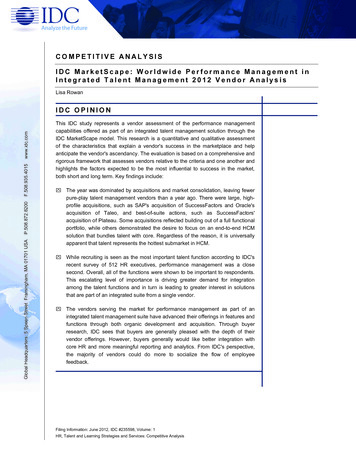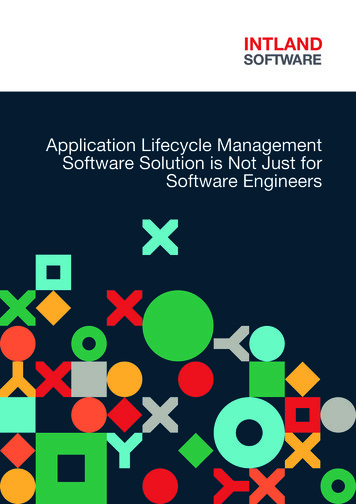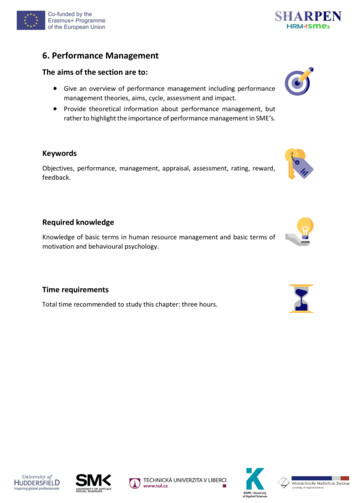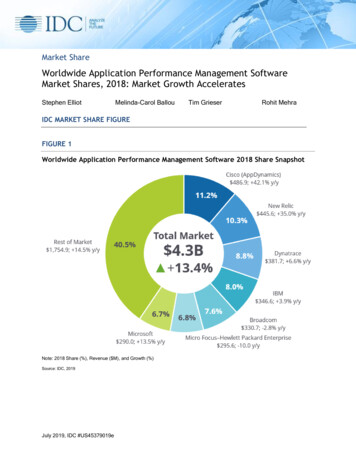
Transcription
Market ShareWorldwide Application Performance Management SoftwareMarket Shares, 2018: Market Growth AcceleratesStephen ElliotMelinda-Carol BallouTim GrieserRohit MehraIDC MARKET SHARE FIGUREFIGURE 1Worldwide Application Performance Management Software 2018 Share SnapshotNote: 2018 Share (%), Revenue ( M), and Growth (%)Source: IDC, 2019July 2019, IDC #US45379019e
IN THIS EXCERPTThe content for this excerpt was taken directly from Worldwide Enterprise Mobility ManagementSoftware 2014-2018 Forecast and 2013 Vendor Shares (Doc# US45379019). All or parts of thefollowing sections are included in this excerpt: Executive Summary, Advice for Technology Suppliers,Market Share, Who Shaped the Year, Market Context, Methodology sections that relate specifically toAppDynamics, and any figures and or tables relevant to AppDynamics.EXECUTIVE SUMMARYAccording to IDC estimates, the worldwide application performance management (APM) software andsoftware-as-a-service (SaaS) market revenue totaled 4.3 billion in 2018 as calculated in U.S. currentcurrency. Revenue in this market showed strong growth, increasing by 13.4% from 2017. Revenueand market share leadership in 2018 was gained by vendors that achieved high year-over-year (y/y)growth. Cisco (AppDynamics) and New Relic were the fastest growing of the top 10 APM suppliers.Refer back to Figure 1 for a graphical snapshot view of the top vendor market revenue, market shares,and growth rates. Refer to Table 1 for a more detailed list of software vendors in this market.This IDC study discusses 2018 vendor market shares and market activity across the worldwideapplication performance management market.According to Stephen Elliot, program vice president, Enterprise System Management Software,"Growth in APM is being driven by the need to manage application performance throughout theapplication life cycle from DevOps to production operations to ensure that end-user experience meetscompetitive quality standards. End-user satisfaction with application performance and reliability iscritical for successful digital business operations."ADVICE FOR TECHNOLOGY SUPPLIERSAs the worldwide APM software market continues to expand, established players and longtime marketstalwarts such Broadcom (CA Technologies) and IBM continue to lose share to more modern platformbased solutions from focused players such as New Relics, Dynatrace, and AppDynamics (Cisco) aswell as APM solutions offered as part of public cloud marketplaces and enterprise cloud services.Public cloud services providers such as Oracle and Microsoft continued to promote a new generationof APM SaaS solutions. Established APM SaaS vendors such as New Relic, Dynatrace, andAppDynamics expanded infrastructure monitoring and business insight analytics to extend the valueand visibility of their services, while infrastructure monitoring players such as Datadog entered theAPM market. End-user monitoring continued to represent an important growth area as enterprisesinvest in APM to support DevOps and digital transformation initiatives. Riverbed's Aternity acquisitionstrengthened the end-user portion of its portfolio.To stay competitive and gain as much market share as possible in the coming years, IDC recommendsthat the technology suppliers in the market address the following priorities: Expand efforts to engage with DevOps and line-of-business (LOB) decision makers that areusing public cloud services and embracing multicloud strategies and cross-functionalcapabilities for analytics and quality. IDC's research shows APM is a significant investmentpriority for IT and DevOps decisions that need to maintain consistent end-user experiences 2019 IDC#US45379019e2
and meet stringent service-level agreements (SLAs) for applications deployed across multiplecloud infrastructure and services, including on-premise, hosted, and shared public cloudservice platforms. Provide robust support for cloud-native, container, and microservice-based applications.Enterprise customers are pursuing strategies to containerize both existing and new cloudnative workloads to improve multicloud portability and enable more efficient utilization of VMs.To remain relevant, APM solutions must be able to monitor, analyze, and detect the root causefor applications deployed on ephemeral containers as well as deployed on more traditionalstateful hosts. Extend analytics capabilities organically or through partnerships to cover the full stack frominfrastructure and public cloud services to middleware, mobile, and on-premises development.The more that applications are instrumented to generate not only code and web trafficstatistics but also end-user experience and behavioral insights, the more that customers willdemand to harvest new insights from that data. Big data analytics will increasingly be pairedwith APM to provide developers, IT operations, and business analysts with important andactionable insights. Deliver true, seamless, omni-channel visibility and reporting. Customers increasingly engagewith a single application across mobile, desktop, and API-based interfaces. APM and relatedanalytics solutions will be called upon to provide a 360-degree view of application and enduser performance to help predict capacity requirements, optimize workloads, and improvesoftware quality, end-user experiences, and engagement. We also see this playing a key rolefor DevOps visibility and execution. Combined performance, event, quality, and networkmanagement data enable essential user context for optimized APM.MARKET SHAREAccording to IDC estimates, the worldwide APM software market totaled just over 4.3 billion in 2018as measured in current currency. Growth of the worldwide APM software market was 13.4% in 2018when compared with last year.As shown in Table 1, Cisco (AppDynamics) took the top spot with a 11.2% market share on revenue of 486.9 million. New Relic grew strongly to achieve market share of 10.3% on revenue of 445.6million. Dynatrace was third with 8.8% market share and 381.7 revenue. 2019 IDC#US45379019e3
TABLE 1Worldwide Application Performance Management Software Revenue by Vendor,2016–2018 ( M)Vendor2016201720182018Share (%)2017–2018Growth (%)Cisco (AppDynamics)232.6342.8486.911.242.1New 446.93,821.04,332.1100.013.4Source: IDC, 2019WHO SHAPED THE YEARAs part of Cisco, AppDynamics has continued to expand its partner and distribution reach, usingCisco's extensive partner network and sales teams. AppDynamics has spent significant time creatingnew packaging and pricing options for Cisco customers, as they invest in marketing to drive the APMvalue proposition into network and security-related channel partners. AppDynamics has executivelevel visibility, as the company now reports to Cisco's EVP and General Manager, Networking andSecurity Business, David Goeckeler. From a product perspective, AppDynamics continues to developnew capabilities for both the on-premises and SaaS offerings, including launching a new Europeansoftware-as-a-service (SaaS) offering, built on the Amazon Web Services (AWS) EU (Frankfurt) regionin June 2018. It also looks to further integrate and expand with Cisco's extensive network andmulticloud management capabilities. AppDynamics also expanded Business iQ, a significant functionalexpansion designed to link application performance to business analytics. AppDynamics CognitionEngine provides artificial intelligence (AI) and machine learning (ML) capabilities.MARKET CONTEXTWorldwide Application Performance Management Software Revenue byRegion, 2018Vendor revenue in this market was impacted by regional conditions. Figure 2 provides a snapshot ofthe market in 2018 by geographic region. The Americas region had the largest share, with 62.7% of 2019 IDC#US45379019e4
the worldwide APM software revenue. EMEA represents 22.6%, and Asia/Pacific (including Japan)(APJ) represents 14.7%.FIGURE 2Worldwide Application Performance Management Software Revenue Share byRegion, 2018Source: IDC's Worldwide Semiannual Software Tracker, April 2019Worldwide Application Performance Management Software Revenue byDeployment Type, 2018Figure 3 provides a snapshot of the market in 2018 by deployment type. Public cloud services revenueamounted to 26.8% of the market. On-premise/other deployments accounted for 73.2%. 2019 IDC#US45379019e5
FIGURE 3Worldwide Application Performance Management Software Revenue Share byDeployment Type, 2018Source: IDC's Worldwide Semiannual Software Tracker, April 2019Significant Market DevelopmentsThe worldwide APM market continues to be delivered in a mixture of public cloud SaaS and onpremises solutions. SaaS solutions have become widely accepted with just about every major playerintroducing or expanding a SaaS option. In many cases, the inherent on-demand scalability and globalreach of SaaS, as well as the increasingly powerful big data analytics and AI support provided byhighly scalable SaaS solutions, make them a great match for DevOps and cloud-based applications.Applications often experience unexpected changes in performance and frequent changes andupdates, thanks to agile development methodologies as well as continuous deploy and iterative cycles.It is also important to note that most vendors are positioning around analytics and broad and deep datacollection capabilities. The notion of real-time data collection and analysis is rising and increasinglyimportant for enterprise IT customers that are shifting more container and microservice-basedworkloads toward the public cloud infrastructures and PaaS models. As the use of cloud-nativeapplications rises, so will the need for real-time capabilities as these environments change often andfast and are typically geographically distributed.METHODOLOGYThe IDC software market sizing and forecasts are presented in terms of commercial software revenue.IDC uses the term commercial software to distinguish commercially available software from customsoftware. Commercial software is programs or codesets of any type commercially available throughsale, lease, rental, or as a service. Commercial software revenue typically includes fees for initial andcontinued right-to-use commercial software licenses. These fees may include, as part of the license 2019 IDC#US45379019e6
contract, access to product support and/or other services that are inseparable from the right-to-uselicense fee structure, or this support may be priced separately. Upgrades may be included in thecontinuing right of use or may be priced separately. These are counted by IDC as commercial softwarerevenue.Commercial software revenue excludes service revenue derived from training, consulting, andsystems integration that is separate (or unbundled) from the right-to-use license but does include theimplicit value of software included in a service that offers software functionality by a different pricingscheme. It is the total commercial software revenue that is further allocated to markets, geographicareas, and sometimes operating environments. For further details, see IDC's Worldwide SoftwareTaxonomy, 2018: Update (IDC #US44835319, February 2019).Bottom-up/company-level data collection for calendar year 2018 began in January 2019 with in-depthvendor surveys and analysis to develop detailed 2018 company models by market, geographic regionand, in some cases, operating environment.The data presented in this document is IDC estimates only.Note: All numbers in this document may not be exact due to rounding.MARKET DEFINITIONThe term application performance management (APM) has been adopted by a wide range ofapplication development, test, quality, analytics, and systems and network management packagedsoftware and SaaS vendors. In general, vendors are embracing the term in an attempt to signal tocustomers that their monitoring, testing, reporting, and analytic solutions can provide value to thebusiness and enable visibility into application health and end-user experience. It is, in effect, an effortto distance their offerings from more traditional systems and network management tools that focusedon monitoring the health and status of specific hardware or software components but did not providean end-to-end perspective or business context.This document discusses the worldwide APM software market, which includes APM solutionsdeployed and running on distributed and mainframe operating environments. It also includes APMsolutions deployed via SaaS. In developing this document, IDC defines APM as a competitive softwaremarket representing segments of several functional markets as defined by IDC's Worldwide SoftwareTaxonomy, 2018: Update (IDC #US44835319, February 2019).Specifically, these are: IT operations management Network management Automated software qualityAPM software focuses on monitoring, maintaining, and optimizing the performance and health ofbusiness applications across development, test and quality, datacenter, and network environments.Packaged software and SaaS solutions marketed as end-user experience monitoring (EUEM), realuser monitoring (RUM), and business transaction monitoring (BTM) are generally included in the APMmarket. Many APM solutions include some level of IT analytics and correlation as part of the featureset. To that extent, these analytics are core elements of the APM offering that are included in this 2019 IDC#US45379019e7
market assessment. However, standalone or general-purpose IT operations analytics solutions areexcluded.APM solutions are distinct from more traditional component or system-level monitoring and testingtools in that they are able to look across complex operational environments, discover hardware andsoftware dependencies and topologies, and track transactions, packets, and code traces on an end-toend basis that provides business application impact assessments and context. Increasingly, APMsolutions are incorporating advanced visualization and executive dashboards as well as predictiveanalytics and modeling capabilities to enable rapid and proactive detection, diagnosis, andremediation of application performance problems and incidents — whether the source is linked to code,systems, or network issues. Both agent-based and agentless approaches such as synthetictransaction monitoring are included.Network management products included in this market must specifically report on applicationperformance. Products that provide generic grouping information based on protocols (e.g., HTTP,CIFS, and IP) are excluded. Console-based event correlation engines and event filters as well assystem infrastructure–level event analytics, modeling, and reporting products are also excluded.Solutions that monitor cloud infrastructure as a service (IaaS) exclusively are excluded, althoughcloud-based APM services that monitor and report on application health, quality, and availability areincluded.Performance, stress, and load testing products and some static and dynamic code analytics productsand code analysis capabilities leveraged in conjunction with relevant APM portfolios (and tracked inIDC's automated software quality market) are also included as they provide key capabilities for gainingvisibility into how well applications are performing in conjunction with real user monitoring and codestability. These kinds of solutions also provide the ability to discover and remediate software problems.Functional and regression testing as well as typical test management do not play a role in APM. Alsoexcluded are performance and event management software products, application management, andnetwork management products that focus exclusively on system- or code-level event monitoring, logmanagement, system- or network-specific performance monitoring, reporting and analytics, andrelated management packs and plug-ins.Consistent with IDC's software taxonomy, this competitive market covers both the packaged softwarelicense and the maintenance revenue as well as SaaS-delivered solutions. Software elements ofappliance-based solutions are also included.RELATED RESEARCH Worldwide Semiannual Software Tracker Methodology, 2H18 (IDC #US44834819, April 2019) IDC's Forecast Scenario Assumptions for the ICT Markets and Historical Market Values andExchange Rates, 4Q18 (IDC #US43652019, April 2019) IDC's Worldwide Software Taxonomy, 2018: Update (IDC #US44835319, February 2019) Worldwide Application Performance Management Software Market Shares, 2017: GrowthContinues Amid Shifting Vendor Alignments (IDC #US44399018, November 2018) 2019 IDC#US45379019e8
About IDCInternational Data Corporation (IDC) is the premier global provider of market intelligence, advisoryservices, and events for the information technology, telecommunications and consumer technologymarkets. IDC helps IT professionals, business executives, and the investment community make factbased decisions on technology purchases and business strategy. More than 1,100 IDC analystsprovide global, regional, and local expertise on technology and industry opportunities and trends inover 110 countries worldwide. For 50 years, IDC has provided strategic insights to help our clientsachieve their key business objectives. IDC is a subsidiary of IDG, the world's leading technologymedia, research, and events company.Global Headquarters5 Speen StreetFramingham, MA 01701USA508.872.8200Twitter: @IDCidc-community.comwww.idc.comCopyright NoticeThis IDC research document was published as part of an IDC continuous intelligence service, providing writtenresearch, analyst interactions, telebriefings, and conferences. Visit www.idc.com to learn more about IDCsubscription and consulting services. To view a list of IDC offices worldwide, visit www.idc.com/offices. Pleasecontact the IDC Hotline at 800.343.4952, ext. 7988 (or 1.508.988.7988) or sales@idc.com for information onapplying the price of this document toward the purchase of an IDC service or for information on additional copiesor web rights.Copyright 2019 IDC. Reproduction is forbidden unless authorized. All rights reserved.
application performance management market. According to Stephen Elliot, program vice president, Enterprise System Management Software, "Growth in APM is being driven by the need to manage application performance throughout the application life cycle from DevOps to production operations to ensure that end-user experience meets
